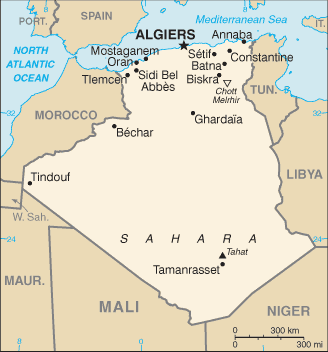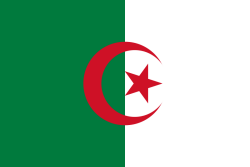Algeria
Related Categories:
 Algeria - Fotw
Algeria - FotwFlag, naval ensign, presidential flag.
www.fotw.us/flags/dz.html Algeria - wikipedia.org
Northern Algeria is in the temperate zone and has a mild, Mediterranean climate. It lies within approximately the same latitudes as southern California and has somewhat similar climatic conditions.
en.wikipedia.org/
Ninety-one percent of the Algerian population lives along the Mediterranean coast on 12% of the country's total land mass. Forty-five percent of the population is urban, and urbanization continues, despite government efforts to discourage migration to the cities. About 1.5 million nomads and semi-settled Bedouin still live in the Saharan area.
Nearly all Algerians are Muslim, of Arab, Berber, or mixed Arab-Berber stock. Official data on the number of non-Muslim residents is not available, however practitioners report it to be less than 5,000. Most of the non-Muslim community is comprised of Methodist, Roman Catholic and Evangelical faiths; the Jewish community is virtually non-existent. As of November 2005, there were about 1,100 American citizens in the country, the majority of whom live and work in the oil/gas fields in the south.
Algeria's educational system has grown dramatically since the country gained its independence. In the last 12 years, attendance has doubled to more than 5 million students. Education is free and compulsory to age 16. Despite government allocation of substantial educational resources, population pressures and a serious shortage of teachers have severely strained the system. Modest numbers of Algerian students study abroad, primarily in Europe and Canada. In 2000, the government launched a major review of the country's educational system and in 2004 efforts to reform the educational system began.
Housing and medicine continue to be pressing problems in Algeria. Failing infrastructure and the continued influx of people from rural to urban areas have overtaxed both systems. According to the United Nations Development Program, Algeria has one of the world's highest per housing unit occupancy rates, and government officials have publicly stated that the country has an immediate shortfall of 1.5 million housing units.
www.state.gov/r/
Introduction
About
Contact
Symbols in The News
Interpret this Symbol
AAC
African
AI
Alchemy
Alphabets
Ancient
Animal Symbolism
Architecture
Art
Articles
Astrology
Baha'i
Blissymbolics
Blueprint Symbols
Buddhist
Celtic Symbols
Cemetery
Chinese Symbols
Christian
Circle
City
Codes
Color
Conlangs
Crop Circles
Danger
Da Vinci Code
Designing Logos
Dictionaries
Dreams
Education
Egyptian Symbols
Electrical
Emoticons
Find Images
Fonts
Food
Fraternity
Hamsa
Healing
Heraldry
Hermetic
Highway Signs
Hindu
History
Hobo
Holiday
Icons
iConji
Islamic
Jain Symbols
Japanese, Kanji
Jewish
Justice
Law
Literary Symbolism
Mandalas
Map
Masonic
Math, Number
Meaning of Names
Medical
Middle East
Military
Miscellaneous
Money
Music
Mythology
Native American
Playing Cards
Power
Psychology
QiQiiKhu
Reiki
Religious
Runes, Norse
Sacred Geometry
Scientific
Science Fiction
Sorority
Sports
Symbols in the News
Tattoos
ThirteenSymbols
Tree of Life
Ursprache
Videos
Visual Languages
Weather
Web Codes
Wicca
Words
Writing Systems
Braille
Coinherence
Coptic
Cuneiform
Easter Island
Etruscan
Happy Human
Hebrew
Kokopelli
Linear B
Lotus
Love Symbols
Mandorla
Moon Alphabet
Nine Pointed Star
Om
Oz
Phonetic
Scarab Beetle
Silent
Theosophy
Unifon
About
Contact
Symbols in The News
Interpret this Symbol
AAC
African
AI
Alchemy
Alphabets
Ancient
Animal Symbolism
Architecture
Art
Articles
Astrology
Baha'i
Blissymbolics
Blueprint Symbols
Buddhist
Celtic Symbols
Cemetery
Chinese Symbols
Christian
Circle
City
Codes
Color
Conlangs
Crop Circles
Danger
Da Vinci Code
Designing Logos
Dictionaries
Dreams
Education
Egyptian Symbols
Electrical
Emoticons
Find Images
Fonts
Food
Fraternity
Hamsa
Healing
Heraldry
Hermetic
Highway Signs
Hindu
History
Hobo
Holiday
Icons
iConji
Islamic
Jain Symbols
Japanese, Kanji
Jewish
Justice
Law
Literary Symbolism
Mandalas
Map
Masonic
Math, Number
Meaning of Names
Medical
Middle East
Military
Miscellaneous
Money
Music
Mythology
Native American
Playing Cards
Power
Psychology
QiQiiKhu
Reiki
Religious
Runes, Norse
Sacred Geometry
Scientific
Science Fiction
Sorority
Sports
Symbols in the News
Tattoos
ThirteenSymbols
Tree of Life
Ursprache
Videos
Visual Languages
Weather
Web Codes
Wicca
Words
Writing Systems
Braille
Coinherence
Coptic
Cuneiform
Easter Island
Etruscan
Happy Human
Hebrew
Kokopelli
Linear B
Lotus
Love Symbols
Mandorla
Moon Alphabet
Nine Pointed Star
Om
Oz
Phonetic
Scarab Beetle
Silent
Theosophy
Unifon

